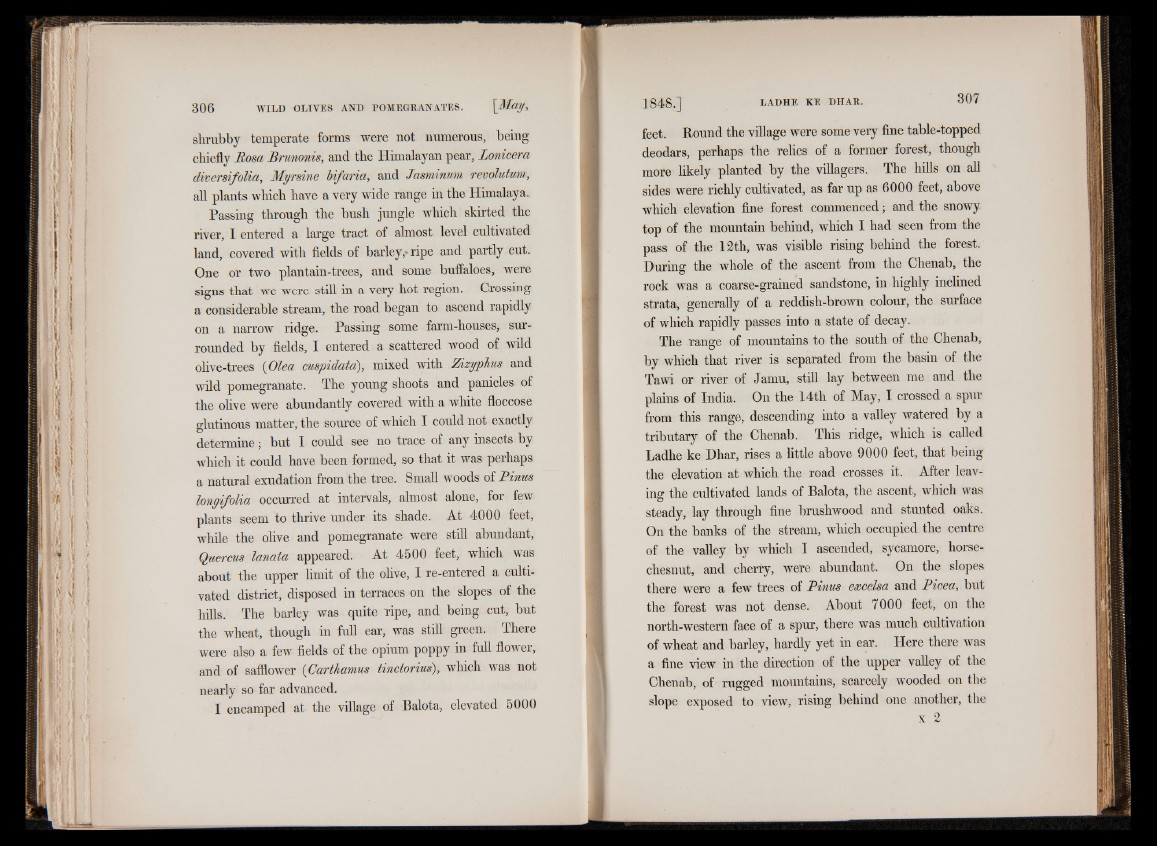
shrubby temperate forms were not numerous, being
chiefly Rosa Brunonis, and the Himalayan pear, Lonicera
diversifolia, Myrsine bifaria, and Jasminum revolutum,
all plants which have a very wide range in the Himalaya.
Passing through the bush jungle which skirted the
river, I entered a large tract of almost level cultivated
land, covered with fields of barley,* ripe and partly cut.
One or two plantain-trees, and some buffaloes, were
signs that we were still in a very hot region. Crossing
a considerable stream, the road began to ascend rapidly
on a narrow ridge. Passing some farm-houses, surrounded
by fields, I entered a scattered wood of wild
olive-trees (Olea cuspidata), mixed with Zizyphus and
wild pomegranate. The young shoots and panicles of
the olive were abundantly covered with a white floccose
glutinous matter, the source of which I could not exactly
determine; but I could see no trace of any insects by
which it could have been formed, so that it was perhaps
a natural exudation from the tree. Small woods of Pinus
longifolia occurred at intervals, almost alone, for few
plants seem to thrive under its shade. At 4000 feet,
while the olive and pomegranate were still abundant,
Quercus lanata appeared. At 4500 feet, which was
about the upper limit of the olive, I re-entered a cultivated
district, disposed in terraces on the slopes of the
hills. The barley was quite ripe, and being cut, but
the wheat, though in full ear, was still green. There
were also a few fields of the opium poppy in full flower,
and of safflower (Carthamus tinctorius), which was not
nearly so far advanced.
I encamped at the village of Balota, elevated 5000
feet. Round the village were some very fine table-topped
deodars, perhaps the relics of a former forest, though
more likely planted by the villagers. The hills on all
sides were richly cultivated, as far up as 6000 feet, above
which elevation fine forest commenced; and the snowy
top of the mountain behind, which I had seen from the
pass of the 12th, was visible rising behind the forest.
During the whole of the ascent from the Chenab, the
rock was a coarse-grained sandstone, in highly inclined
strata, generally of a reddish-brown colour, the surface
of which rapidly passes into a state of decay.
The range of mountains to the south of the Chenab,
by which that river is separated from the basin of the
Tawi or river of Jamu, still lay between me and the
plains of India. On the 14th of May, I crossed a spur
from this range, descending into a valley watered by a
tributary of the Chenab. This ridge, which is called
Ladhe ke Dhar, rises a little above 9000 feet, that being
the elevation at which the road crosses it. After leaving
the cultivated lands of Balota, the ascent, which was
steady, lay through fine brushwood and stunted oaks.
On the banks of the stream, which occupied the centre
of the valley by which I ascended, sycamore, horse-
chesnut, and cherry, were abundant. On the slopes
there were a few trees of Pinus excelsa and Picea, but
the forest was not dense. About 7000 feet, on the
north-western face of a spur, there was much cultivation
of wheat and barley, hardly yet in ear. Here there was
a fine view in the direction of the upper valley of the
Chenab, of rugged mountains, scarcely wooded on the
slope exposed to view, rising behind one another, the
x 2